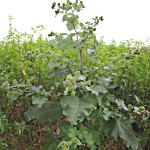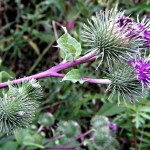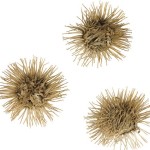Burdock Root – Arctium lappa
|
Current Demand = Normal |
Parts Used: Root |
 |
 |
 |
 |
Common Names: greater burdock, gobō, edible burdock, lappa, fox’s clote, thorny burr, beggar’s buttons, cockle buttons, love leaves, philanthropium, personata. happy major, clot-bur…
Description
Burdock is a tall, up to 9 feet, branching biennial that has rounded to arrow-shaped leaves and purple flower heads encased in bracts with hooked tips. It likes to grow along roadsides, fences and walls. It has a long fleshy gray root with a reddish stem and wooly branches. It grows well in the wilds and thrives in light, well-drained soil.
The mature flower becomes a brown bur, bristling with spines. Each spine is tipped with a very sharp tiny hook which catches and clings to clothing and to the hair and fur of animals. A dog’s coat, sheep’s wool, and the tails of horses and cattle frequently become matted with these burs. Thus the plant spreads its seeds.
Planting
As the Burdock grows freely in waste places and hedgerows, it can be collected in the wild state, and is seldom worth cultivating.
It will grow in almost any soil, but the roots are formed best in a light well-drained soil. The seeds germinate readily and may be sown directly in the field, either in autumn or early spring, in drills 18 inches to 3 feet apart, sowing 1 inch deep in autumn, but less in spring. The young plants then need to be thinned out to 6 inches apart in the row.
Harvesting/Drying
Parts Used: root
After harvest, remove all foreign matter (rocks, weeds and other roots) and spread in a thin layer immediately. When possible dry indoors in a well ventilated barn loft or attic to protect from the elements. If natural heat is not available you may need to add heat and a fan for continuous airflow. Whether you dry indoors or outdoors you will need to turn or stir the roots daily.
The key to drying any root, herb or bark is an even combination of heat and airflow. Never dry in an oven or microwave. They can be completely dry (largest stem will snap not bend) in 3-7 days depending on the drying conditions. Once it is dried place the roots carefully into a cardboard box or paper bag for storage in a dry area until you are ready to sell or use. Never store the tubers/roots in plastic or it can mold.
The taproot of young burdock plants can be harvested and eaten as a root vegetable. The root has a sweetish and mucilaginous taste. Plants are cultivated for their slender roots, which can grow about 1 meter long and 2 cm across. Immature flower stalks may also be harvested in late spring, before flowers appear; the taste resembles that of artichoke to which the burdock is related.
The roots are dug in summer. As a rule they are 12 inches or more in length and about 1 inch thick, sometimes, however, they extend 2 to 3 feet, making it necessary to dig by hand. They are fleshy, wrinkled, crowned with a tuft of whitish, soft, hairy leaf-stalks, grey-brown externally, whitish internally, with a somewhat thick bark, and soft wood tissues with a radiate structure.
Attributes (Image)
Christian Fischer [CC BY-SA 3.0], via Wikimedia Commons
By Roger Culos (Own work) [CC BY-SA 3.0], via Wikimedia Commons
By Nwbeeson (Own work) [CC BY-SA 4.0], via Wikimedia Commons
 Root Buyer
Root Buyer